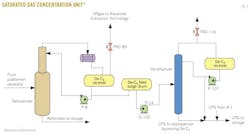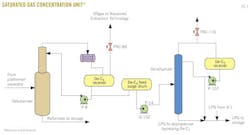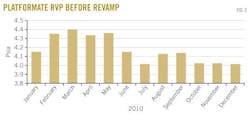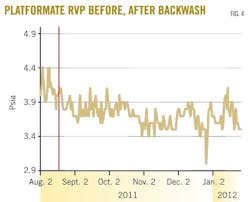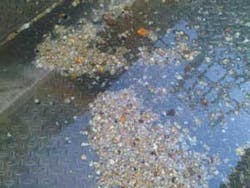Platformer debutanizer revamp lowers rvp at Middle East refinery
Rakan S. Bilaus
Saudi Aramco
Dhahran
Sajeesh Padmanabhan
UOP
Dubai
Efforts during 2010-11 at Saudi Aramco's Yanbu refinery to rectify high reformate Reid vapor pressure (rvp) have increased the refinery's revenue.
The high reformate rvp was imposing blending constraints, resulting in reduced i-C5 and isomerate blending and research octane number (RON) giveaway. Saudi Aramco concluded with a debutanizer revamp implemented in early 2011. As a result, the reformate rvp dropped to 3.8 psia from 4.5.
During summer 2011, however, several performance issues appeared. Optimization and overcoming cooling limitations resulted in performance improvements and a further drop in rvp to 3.7 psia from 3.9. The reduction of platformate rvp allows for an addition of 1,000 bbl of i-C5 to the gasoline pool.
Reformate
High reformate rvp causes problems with gasoline blending leading to high rvp in summer months, resulting in reduced i-C5 and isomerate blending. Consequently, gasoline production is reduced with an RON giveaway. In order to increase gasoline production and eliminate RON giveaway, reformate rvp needed to be reduced to 3.8 psia from 4.5 psia. Accordingly, a study was initiated to look into the available options to upgrade Yanbu refinery platforming debutanizer column to achieve the targeted rvp at full column capacity.
The purpose of the platforming unit is to upgrade low-octane heavy naphtha from a naphtha hydrotreating unit to a high-octane material for motor fuel blending. The principal product is high-octane reformate (sent to a saturated gas concentration for vapor pressure adjustment), whereas a hydrogen-rich gas is produced as a by-product and sent to the naphtha hydrotreating unit and light straight-run naphtha hydrotreating unit. The unit consists of the following:
• Reaction section: mainly three heaters and three reactors, in which reforming reaction takes place.
• Compressor section: three centrifugal compressors for recycle-gas service and two alternative compressors for hydrogen makeup gas sent to the hydrotreating units.
• Product separation section: reformate recovered from the hydrogen-rich gas by a chilling unit.
The saturate-gas concentration processes the unsterilized platformate produced in the platforming unit and the treated LPG coming from the LPG Merox unit. Products are stabilized platformate, propane, butane, and/or mixed LPG. Components lighter than propane are sent to the refinery's fuel-gas network.
The unit consists of the following (Fig. 1):
• Debutanizer (de-C4) tower reboiled by means of the fired heater that separates unstabilized platformate in LPG as overhead product and stabilized platformate as bottoms product.
• De-ethanizer (de-C2) tower reboiled with medium-pressure steam that removes components' lighter than C3 from LPG.
• Depropanizer (de-C3) tower reboiled with medium-pressure steam that splits LPG into propane as overhead product and butane as bottom product.
The debutanizer column was designed by Chiyoda Corp. in 1977, and the column internals were provided by Koch Glitsch LP.
When the platformer unit was converted to continuous catalytic reforming (CCR) in 2006, the column was deemed suitable for the new process flows. The only modifications were new feed-bottoms exchangers and new overhead trim coolers. The main function of the column is to stabilize reformate and produce LPG as an overhead product.
The main specs were <1.0 mole % C4 in reformate and <1.0 mole % C5 in LPG. The reformate was estimated to have an rvp of 3.8 psia. The reformate rvp, however, has been consistently at 4.5 psia at full unit capacity.
It is possible to reduce the reformate rvp by increasing the LPG draw to decrease the C4 components in the reformate. This, however, will result in higher C5 content in the LPG, causing it to be off-specification.
Furthermore, the reflux temperature was having considerable impact on column operations. The design temperature was 38˚ C., but over time, the reflux temperature has gradually shifted higher. During summer peaks, the temperature had been reported as high as 50˚ C. (Fig. 2).
Study basis, scope
Piping flow diagrams, plant information (PI) data system, and Chiyoda's mechanical drawings of the saturated gas concentration unit were used as a basis of the study. The study would have the following outcomes:
1. Provide detailed simulation of the unit with tray-by-tray rating calculations.
2. Identify the hydraulics limitations contributing to low tray efficiency.
3. Provide sensitivity analysis for reflux temperature.
4. Provide changes to internals proposed by Glitch to overcome limitations.
The debutanizer column was evaluated for the new process conditions when the fixed-bed platformer was converted to CCR. As per Chiyoda's calculations, the column internals were adequate to produce a reformate rvp of 3.8 psia.
In order to validate the process design, Saudi Aramco simulated the debutanizer column with full capacity under design conditions. The results showed that for design process conditions a 30-tray debutanizer column is adequate for producing reformate with a 3.8 psia rvp. Once the process calculations were verified, the next step was to perform the hydraulic check for the rated dimensions to check for any limitations. A detailed tray-by-tray analysis showed high flooding percentage (80-89%) in the rectification section.
To verify the results, Glitch performed a detailed hydraulic check for the column, which yielded the following comments:
1. Tray Nos. 1-15 are working close to their limits (jet flooding 83%; limit is 85%).
2. High exit velocity of Tray No. 5; 1.58 m/sec.
3. Velocities and head losses under downcomers of Tray Nos. 16-30 are above maximum.
4. Vapor tunnel on off-center downcomer of Tray No. 30 was not provided.
5. Inlet momentum through the existing feed distributor is too high.
Although the debutanizer column has sufficient trays to provide a reformate quality of 3.8 psia rvp, the poor performance can be attributed to smaller diameter of the rectification section for sieve-tray application, improper vapor and liquid disengagement at the feed tray, higher than recommended downcomer exit velocity, and improper distribution of the reboiler return vapor.
The rectification efficiency was found to be about 60%; the stripping section efficiency about 40%.
Since the reflux temperature had been gradually increasing to higher than the design temperature of 38˚ C., it was important to understand its effect on column performance. It was found that at reduced capacity, the reflux temperature has negligible effect on reformate and LPG quality. The quality of reformate and LPG, however, is sensitive to reflux temperature at full capacity.
Recommendations; implementation
Based on these outcomes, the recommendations to improve reformate rvp to 3.8 psia were as follows:
1. Replace the existing trays with minivalve trays at Tray Nos. 1-15.
2. Replace the existing distributor with a new flashing feed pipe.
3. Replace existing lower downcomer panels to increase clearance.
4. Replace two thirds of existing off-center downcomer panels of Tray No. 30 with vapor tunnel.
The study was completed with recommendations in August 2010. The Yanbu refinery managed to implement all the recommendations during a total refinery shutdown in February 2011.
Implementation of the study recommendations resulted in a reduction in reformate rvp to 4.1 psia from 4.5 psia after shutdown. The debutanizer operating parameters after the start-up were not optimized to meet the targeted rvp (Fig. 3).
• Operating parameters optimization. The debutanizer column started operating with a reboiler outlet temperature of 236˚ C., Tray No. 8 temperature of 100˚ C., and a reflux ratio of 4.2. These operating parameters, however, were not achieving the target rvp.
Saudi Aramco then adjusted the operating parameters to a reboiler outlet temperature of 240˚ C., Tray No. 8 temperature of 105˚ C., and a reflux ratio of 5.0. As a result, the reformate average rvp dropped to 3.8 psia. During summer peak, however, the reformate rvp increased to 4.0 psia.
• Overhead cooling limitations. During summer, the reflux temperature was reported high, 40-50˚ C., which was affecting column operations. A performance assessment on the debutanizer overhead trim coolers V14-E-103A-D indicated that they were operating at 35-40%. The trim coolers were designed to use 500 cu m/hr of seawater for cooling, while the total seawater flow was around 150 cu m/hr, which clearly pinpoints a problem in the seawater side.
• Overcoming cooling limitations. To overcome the cooling limitations, a backwash was conducted for the debutanizer overhead trim coolers V14-E-103A-D, in which the flow of seawater was reversed. As a result, the reversed flow of seawater removed a large amount of plugging material from the system.
Consequently, the reflux temperature dropped from 45˚ C. to 33˚ C. allowing for more cooling. The backwash greatly improved the overhead cooling capacity. Consequently, the platformate rvp has dropped to an average of 3.5-3.7 psia from an average of 3.9 psia (Fig. 4).
The reduction of platformate rvp allows for an addition of 1,000 bbl of i-C5 to the gasoline pool. Furthermore, as a result of backwashing, the debutanizer off gases were reduced by more than 1,000 cu m/hr, resulting in an increase in LPG production by 300 b/d. The trim coolers were badly plugged, as shown in Fig. 5.
| Debutanizer trim coolers were badly plugged (Fig. 5). |
Backwashing the debutanizer overhead trim coolers V14-E-103A-D resulted in additional benefits:
1. Increased seawater flow by more than 100 cu m/hr.
2. Increased LPG production by 300 b/d.
3. Decreased reflux temperature by more than 10˚ C.
4. Significantly improved debutanizer overhead cooling system.
5. Relaxed operation of the debutanizer column.
The authors
Rakan S. Bilaus is a process engineer specializing in catalytic conversion processes for Saudi Aramco, which he joined in 2008. He has been involved in the design and evaluation of several of flare and relief systems at Saudi Aramco plants. He joined several refineries as a process engineer, handling several process units, starting with crude distillation, and ending with fluid catalytic cracking and CCR platformer complexes. Bilaus holds a bachelors in chemical engineering from McMaster University, Hamilton, Ont.
Sajeesh Padmanabhan is a senior technical support specialist for UOP, Dubai. He was employed by Saudi Aramco 2005-12, where he was involved in the commissioning and start-up of the CCR platformer and isomerization units. He also streamlined diesel hydrotreating operations. He started his career with Reliance Industries, India, where he was involved in the commissioning and start-up of the worldscale aromatics complex at Jamnagar. He worked with Reliance for 9 years. Padmanabhan obtained his bachelors in chemical engineering (1995) from the University of Calicut, India.
